Written Records, AWM54 741/5/9 PART 2 - [Patrols - Reconnaissance:] Report on Northern Territory Special Reconnaissance Unit, by Sqn Ldr D F Thomson RAAF [Report minus maps] - Part 1
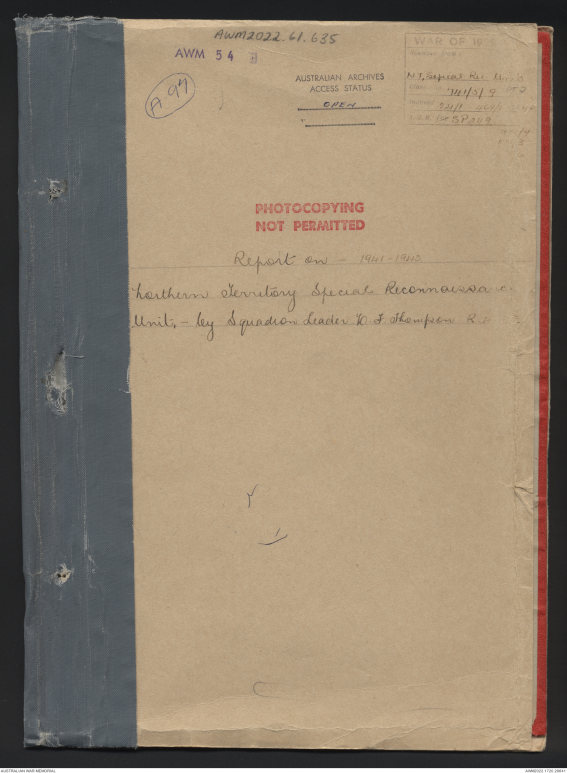

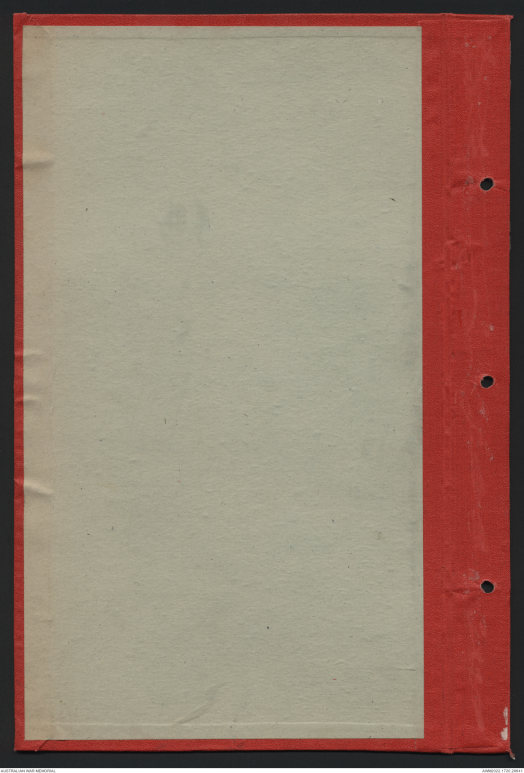
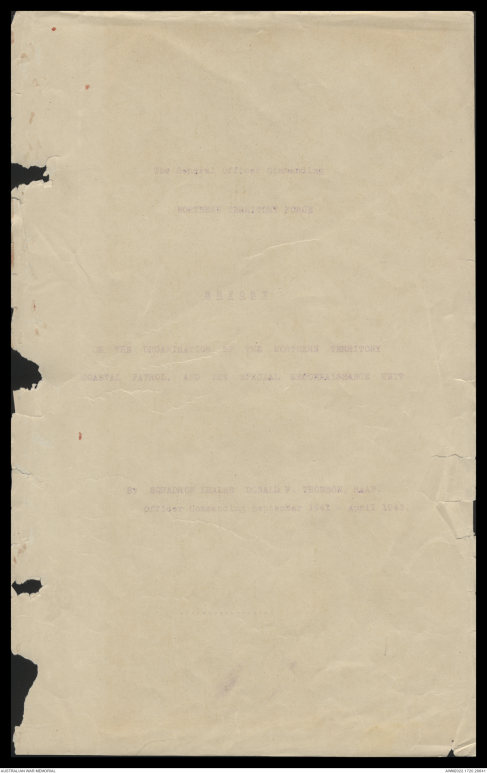
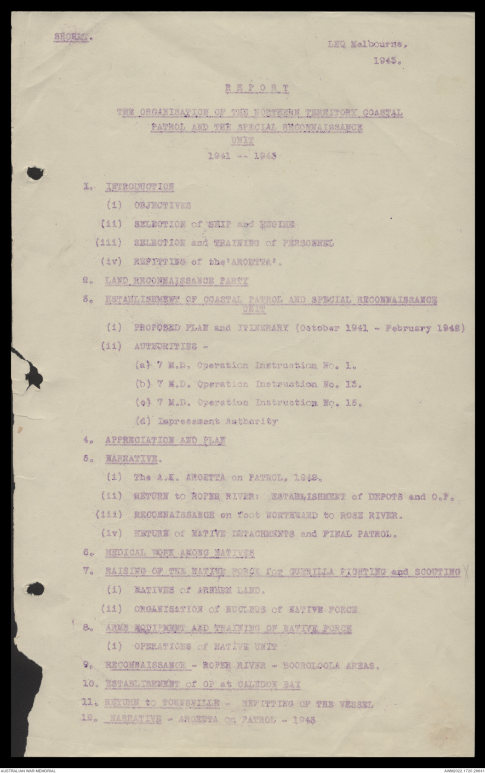
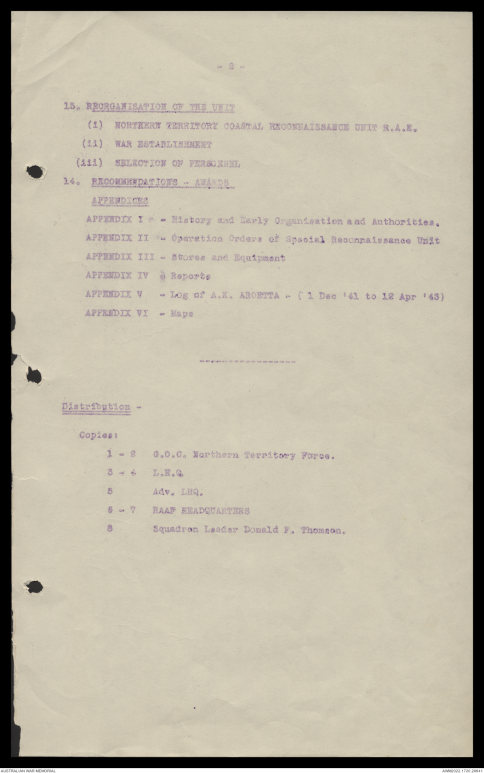
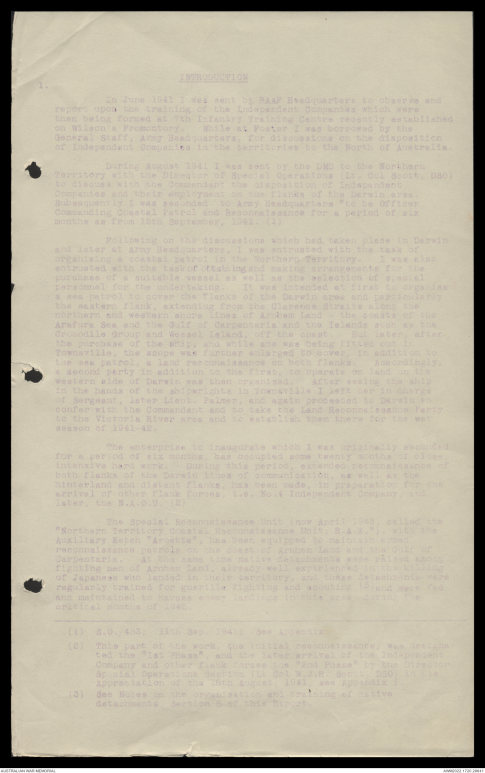
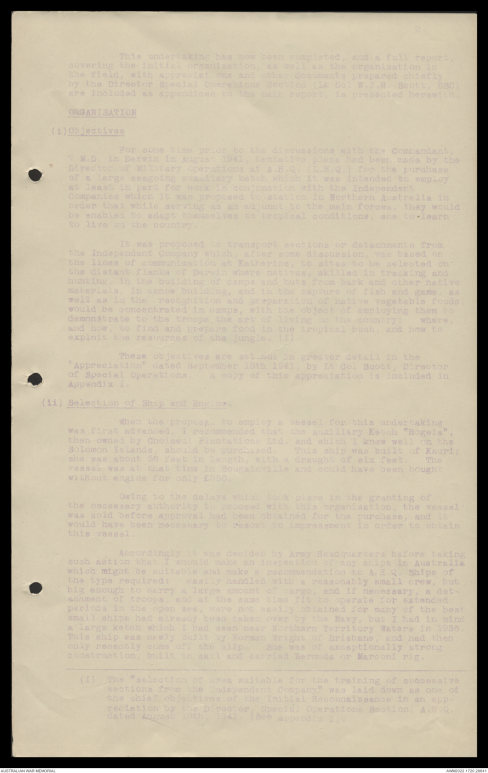
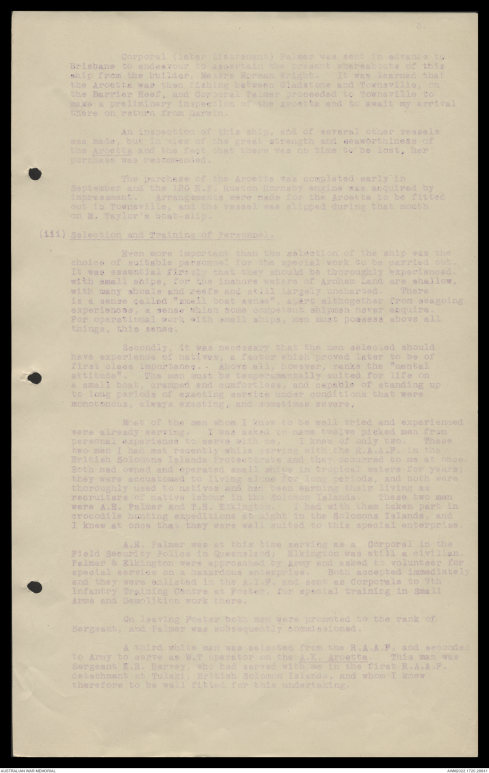
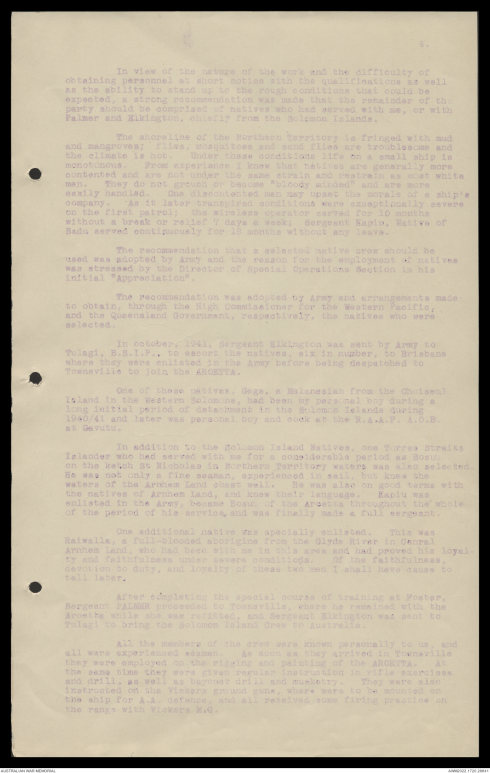
AWM2022.61.635
AWM 54
A 97
WAR OF 19
N T. Special Rec Units
[[?]]741/5/9 PT 2
[[?]] 933/1 469/1 [[?]]
[[?]] SP249
[[?]]/4
[[?]]3
AUSTRALIAN ARCHIVES
ACCESS STATUS
OPEN
.........................................................
...................................................
PHOTOCOPYING
NOT PERMITTED
Report on - 1941-1943.
Northern Territory Special Reconnaissance
Unit, - by Squadron Leader D.F. Thompson RAAF
WAR OF 1939-45525/1 Received from:
492/4 N.T. Special Recc. Unit
831/3625/4 Classn. No. 741/5/A
Indexed 721/1. 469/5. 495/2
199/6 A.W.M. File SP 249
R E P O R T
NORTHERN TERRITORY SPECIAL
RECONNAISSANCE UNIT
By Squadron Leader Donald F. THOMSON,
R.A.A.F
1941 - 1943
The Special Officer Commanding
NORTHERN TERRITORY FORCE
S E C R E T
IN THE EXAMINATION OF THE NORTHERN TERRITORY
COASTAL PATROL, AND ITS SPECIAL RECONNAISSANCE UNIT
By SQUADRON LEADER DONALD F. THOMSON R.A.A.F,
Officer Commanding September 1941 - April 1943.
SECRET.
LEQ Melbourne.
1945.
R E P O R T
THE ORGANISATION OF THE NORTHERN TERRITORY COASTAL
PATROL AND THE SPECIAL RECONNAISANCE
UNIT
1941 - 1945
1. INTRODUCTION
(i) OBJECTIVES
(ii) SELECTION of SHIP and ENGINE
(iii) SELECTION and TRAINING of PERSONNEL
(iv) REFITTING of the 'AROETTA'.
2. LAND RECONNAISSANCE PARTY
3. ESTABLISHMENT OF COASTAL PATROL AND SPECIAL RECONNAISSANCE UNIT
(i) PROPOSED PLAN and ITINERARY (October 1941 – February 1943)
(ii) AUTHORITIES –
(a) 7 M.D. Operation Instruction No. 1.
(b) 7 M.D. Operation Instruction No. 13.
(c) 7 M.D. Operation Instruction No. 16.
(d) Impressment Authority
4. APPRECIATION AND PLAN
5. NARRATIVE.
(i) The A.K. AROETTA on PATROL, 1942.
(ii) RETURN to ROPER RIVER: ESTABLISHMENT of DEPOTS and O.P.
(iii) RECONNAISSANCE on foot NORTHWARD to ROSE RIVER.
(iv) RETURN of NATIVE DETACHMENTS and FINAL PATROL.
6. MEDICAL WORK AMONG NATIVES
7. RAISING OF THE NATIVE FORCE for GUERILLA FIGHTING and SCOUTING
(i) NATIVES of ARNHEM LAND.
(ii) ORGANISATION of NUCLEUS of NATIVE FORCE
8. ARMS EQUIPMENT AND TRAINING OF NATIVE FORCE
(i) OPERATIONS of NATIVE UNIT
9. RECONNAISSANCE - ROPER RIVER - BOROLOOLA AREAS.
10. ESTABLISHMENT of OP at CALEDON BAY
11. RETURN to TOWNSVILLE - REFITTING OF THE VESSEL.
12. NARRATIVE - AROETTA on PATROL - 1943
-2-
13. REORGANISATION OF THE UNIT
(i) NORTHERN TERRITORY COASTAL RECONNAISSANCE UNIT R.A.E
(ii) WAR ESTABLISHMENT
(iii) SELECTION OF PERSONNEL
14. RECOMMENDATIONS - AWARDS
APPENDICES
APPENDIX I - History and Early Organisation and Authorities.
APPENDIX II - Operation Orders of Special Reconnaissance Unit
APPENDIX III - Stores and Equipment
APPENDIX IV - Reports
APPENDIX V - Log of A.K. AROETTA - (1 Dec '41 to 12 Apr '43)
APPENDIX VI - Maps
- - - - - - - - - - - -
Distribution –
Copies:
1 - 2 G.O.C. Northern Territory Force.
3 - 4 L.H.Q.
5 Adv. LHQ.
6 -7 RAAF HEADQUARTERS
8 Squadron Leader Donald F. Thomson.
1. INTRODUCTION
In June 1941 I was sent by RAAF Headquarters to observe and
report upon the training of the Independent Companies which were
then being formed at 7th Infantry Training Centre recently established
on Wilson's Promontory. While at Foster I was borrowed by the
General Staff, Army Headquarters, for discussions on the disposition
of Independent Companies in the territories to the North of Australia.
During August 1941 I was sent by the DMC to the Northern
Territory with the Director of Special Operations (Lt. Col Scott, DSO)
to discuss with the Commandant the disposition of Independent
Companies and their employment on the flanks of the Darwin area.
Subsequently I was seconded to Army Headquarters "to be Officer
Commanding Coastal Patrol and Reconnaissance" for a period of six
months as from 12th September, 1941. (1)
Following on the discussion which had taken place in Darwin
and later at Army Headquarters, I was entrusted with the task of
organising a coastal patrol in the Northern Territory. I was also
entrusted with the task of obtaining and making arrangements for the
purchase of a suitable vessel as well as the selection of special
personnel for the undertaking. It was intended at first to organise
a sea patrol to cover the flanks of the Darwin area and particularly
the eastern flank, extending from the Clarence Straits along the
northern and western shore lines of Arnhem land - the coast of the
Arafura Sea and the Gulf of Carpentaria and the Islands such as the
Crocodile Group and Wessel Island, off the coast. But later, after
the purchase of the ship, and while she was being fitted out in
Townsville, the scope was further enlarged to cover, in addition to
the sea patrol, a land reconnaissance on both flanks. Accordingly,
a second party in addition to the first, to operate on land on the
western side of Darwin was then organised. After seeing the ship
in the hands of the shipwrights in Townsville I left her in charge
of Sergeant, later Lieut., Palmer, and again proceeded in Darwin to
confer with the Commandant and to take the Land Reconnaissance Party
to the Victoria River area and so establish them there for the wet
season of 1941-42.
The enterprise to inaugurate which I was originally seconded
for a period of six months has occupied some twenty months of often
intensive hard work. During this period, extended reconnaissance of
both flanks of the Darwin lines of communication, as well as the
hinterland and distant flanks, has been made, in preparation for the
arrival of other flank forces, i.e. No. 1 Independent Company, and
later, the N.A.C.U (2).
The Special Reconnaissance Unit (now April 1942, called the
"Northern Territory Coastal Reconnaissance Unit, R.A.N."), with the
Auxiliary Ketch "Aroetta", has been equipped to maintain armed
reconnaissance patrols on the coast of Arnhem Land and the Gulf of
Carpentaria. At the same time native detachments were raised from
fighting men of Arnhem Land, already well experienced in the killing
of Japanese who landed in their territory, and these detachments were
regularly trained for guerrilla fighting and scouting and were fed
and maintained to harass every landing in this area during the
critical period of 1942.
_______________________________________________________________________
(1) G.O 483: 11th Sep 1942. See Appendix .
(2) This part of the work, the initial reconnaissance, was designated
the "1st Phase", and the later arrival of the Independent
Company and other flank forces the "2nd Phase" by the Director
Special Operations Section (Lt. Col. W.J.H. Scott DSO), in the
Appreciation of the 26th August 1941. See Appendix 1.
3) See Notes on the organisation and training of native
detachments. Section [[6?]] of this report.
2.
This undertaking has now been completed, and a full report
covering the initial organisation, as well as the organisation in
the field, with [app[?]] [[?]] and other documents prepared chiefly
by the Director Special Operations Section (Lt. Col. W.J.H. Scott. DSC)
are included as appreciation to the main report, is presented herewith.
ORGANISATION
(i) Objectives
For some time prior to the discussions with the Commandant,
7 M.D. in Darwin in August 1941, tentative plans had been made by the
Director of Military Operations at A.H.Q., (L.H.Q) for the purchasing
of a large seagoing auxiliary ketch which it was intended to employ
at least in part for work in conjunction with the Independent
Companies which it was proposed to station in Western Australia in
order that while serving as an adjunct to the main forces they would
be enabled to adapt themselves to tropical conditions and to learn
to live on the country.
It was proposed to transport sections or detachments from
the Independent Company, which after some discussion was based on
the lines of communication at Katherine, to sites to be selected on
the distant flanks of Darwin where natives skilled in tracking and
hunting, in the building of camps and huts from bark and other native
materials, in some building, and in the capture of fish and game, as
well as in the recognition and preparation of native vegetable foods
would be demonstrated in camps, with the object of employing them to
demonstrate to the troops, the art of living in the country. Where
and how, to find and prepare food in the tropical north, and how to
exploit the resources of the jungle. (1)
These objectives are outlined in greater detail in the
"Appreciation" dated Sept/October 18th 1941 by Lt. Col. Scott, Director
of Special Operations. A copy of this appreciation is included in
Appendix 1.
(ii) Selection of Ship and Engines
When the proposal to employ a vessel for this undertaking
was first advanced, I recommended that the Auxiliary Ketch "[[Rogela]]"
then owned by Choiseul Plantations Ltd. and which I knew well on the
Solomon Islands, should be purchased. This ship was built of Kauri,
she was about 60 feet in length with a draught of six feet. The
vessel was at that time in Bougainville and could have been bought
without engine for only £[[?50]].
Owing to the delays with [[?]] plans in the granting of
the necessary authority to proceed with the preparations, the vessel
was sold before approval had been obtained for the purchase, and it
would have been necessary to resort to impressment in order to obtain
this vessel.
Accordingly, it was decided by Army Headquarters before taking
such action that I would make an an inspection of any ship in Australia
which might be suitable and make a recommendation to A.E.Q. Ships of
the type required : easily handled with a reasonably small crew, but
big enough to carry a large amount of cargo, and if necessary, a detachment
of troops, and at the same time fit to operate for extended
periods in the open sea, were not easily obtained for many of the best
small ships had already been taken over by the Navy, but I had in mind
a large ketch which I had seen near Northern Territory waters in 1935.
This ship was newly built by Norman Wright of Brisbane, and had then
only recently come off the slip. She was of exceptionally strong
construction, built in [[sail?]]and carried Bermuda or Marconi rig.
_____________________________________________________________________
(i) The "selection of crew suitable for the training of successive
sections from the "Independent Company" was laid down as one of
the chief objectives of the Initial Reconnaissance in an app-
reciation by the Brigadier Special Operations Section: A.H.Q
dated August 10th 1942. (See Appendix 2.)
3.
Corporal (later Lieutenant) Palmer was sent in advance to
Brisbane to endeavour to ascertain the present whereabouts of this
from the builder, Messrs Norman Wright. It was learned that
the Aroetta was then fishing between Gladstone and Townsville, on
the Barrier Reef, and Corporal Palmer preceded to Townsville to
make a preliminary inspection of the Aroetta and to await my arrival
there on return from Darwin.
An inspection of this ship and of several other vessels
was made, but in view of the great strength and seaworthiness of
the Aroetta and the fact that there was no time to be lost, her
purchase was recommended.
The purchase of the Aroetta was completed early in
September and the IRG N.F. Ruston Hornsby engine was acquired by
impressment. Arrangements were made for the Aroetta to be fitted
out in Townsville, and the vessel was slipped during that month
on M. Taylor's boat slip.
(iii) Selection and Training of Personnel.
Even more important than the selection of the ship was the
choice of suitable personnel for the special work to be carried out.
It was essential firstly that they should be thoroughly experienced
with small ships, for the inshore waters of Arnhem Land are shallow,
with many shoals and reefs and still largely uncharted. There
is a sense called "small boat aware". Apart althogether from seagoing
experiences, a sense which some competent shipmen never acquire.
For operational work, with small ships, men must possess above all
things, this sense.
Secondly, is was necessary that the men selected should
have experience of natives, a factor which proved later to be of
first class importance. Above all, however, ranks the "mental
attitude". The men must be temperamentally suited for life on
a small boat, cramped and comfortless, and capable of standing up
to long periods of exacting service under conditions that were
monotonous, always exacting, and sometimes severe.
Most of the men whom I knew to be well tried and experienced
were already working. I was asked to name twelve picked men from
personal experience to serve with me. I knew of only two. These
two men I had met recently while serving with the R.A.A.F. in the
British Solomon Islands Protectorate and they occurred to me at once.
Both had owned and operated small ships in tropical waters for years;
they were accustomed to living alone for long periods, and both were
thoroughly used to natives and had been earning their living as
recruiters of native labour in the Solomon Islands. These two men
were A.H. Palmer and T.S. Elkington. I had with the taken part in
crocodile hunting expeditions at night in the Solomon Islands, and
I knew at once that they were well suited to this special enterprise.
A.H. Palmer was at this time serving as a Corporal in the
Field Security Police in Queensland. Elkington was still a civilian.
Palmer & Elkington were approached by Army and asked to volunteer for
special service on a hazardous enterprise. Both accepted immediately
and they were enlisted in the A.I.F. and sent as Corporals to 9th
Infantry Training Corps at Foster for special training in small
arms and demolition work there.
On leaving Foster, both men were promoted to the rank of
Sergeant, and Palmer was subsequently commissioned.
A third white man was selected rom the R.A.A.F. and seconded
to Army to serve as W.T. Operator on the A.K. Aroetta. This man was
Sergeant K.R. Harvey, who had served with me in the first R.A.A.F.
detachment at Tulagi, British Solomon Islands, and whom I knew
therefore to be well fitted for this undertaking.
4.
In view of the nature of the work and the difficulty
of obtaining personnel at short notice with the qualifications as well
as the ability to stand up to the rough conditions that could be
expected, a strong recommendation was made that the remainder of the
party should be comprised of natives who had served with me, or with
Palmer and Elkington, chiefly from the Solomon Islands.
The shoreline of the Northern Territory is fringed with mud
and mangroves; flies, mosquitoes and sand flies are troublesome and
the climate is hot. Under these conditions life on a small ship is
monotonous. From experience I know that natives are generally more
contented and are not under the same strain and restrain as white
man. They do not grouch or become "bloody minded" and are more
easily handled. One discontented man may upset the morale of a ship's
company. As it later transpired conditions were exceptionally severe
on the first patrol ; the wireless operator served for 10 months
without a break or relief 7 days a week; Sergeant Kapiu, Native of
Badu, served continuously for 10 months without any leave.
The recommendation that a selected native crew should be
used was adopted by Army and the reason for the employment of natives
was stressed by the Director of Special Operations Section in his
initial "Appreciation".
The recommendation was adopted by Army and arrangements made
to obtain, through the High Commissioner for the Western Pacific,
and the Queensland Government, respectively, the natives who were
selected.
In October, 1941, Sergeant Elkington was sent by Army to
Tulagi, B.S.I.P., to escort the natives, six in number, to Brisbane
where they were enlisted in the Army before being despatched to
Townsville to join the AROETTA.
One of those natives, Gega, a Melanesian from the Choiseul
Island in the Western Solomons, had been my personal boy during a
long initial period of detachment in the Solomon Islands during
1940/41 and later was personal boy and cook at the R.A.A.F. A.O.B.
at Gavutu.
In addition to the Solomon Island Natives, one Torres Strait
Islander who had served with me for a considerable period as Bosun
on the ketch St Nicholas in Northern Territory waters was also selected.
He was not only a fine seaman, experienced in sail, but knew the
waters of Arnhem Land coast well. He was also on good terms with
the natives of Arnhem Land , and knew their language. Kapiu was
enlisted in the Army, became Bosun of the Aroetta throughout the whole
of the period of his service and was finally made a full sergeant.
One additional native was specially enlisted. This was
Raiwalla, a full-blooded aborigine from the Glyde River in Central
Arnhem Land, who had been with me in this area and had proved his loyalty
and faithfulness under severe conditions. Of the faithfulness,
devotion to duty, and loyalty of these two men I shall have cause to
tell later.
After completing the special course of training at Foster
Sergeant PALMER proceeded to Townsville, where he remained with the
Aroetta while she was refitted, and Sergeant Elkington was sent to
Tulagi to bring the Solomon Island Crew to Australia.
All the members of the crew were known personally to us, and
all were experienced seamen. As soon as they arrived in Townsville
they were employed on the rigging and painting of the AROETTA. At
the same time they were given regular instruction in rifle exercises
and drill, as well as bayonet drill and musketry. They were also
instructed on the Vickers ground guns, which were to be mounted on
the ship for A.A. defence, and all received some firing practice on
the range with Vickers M.G.
 Sam scott
Sam scottThis transcription item is now locked to you for editing. To release the lock either Save your changes or Cancel.
This lock will be automatically released after 60 minutes of inactivity.